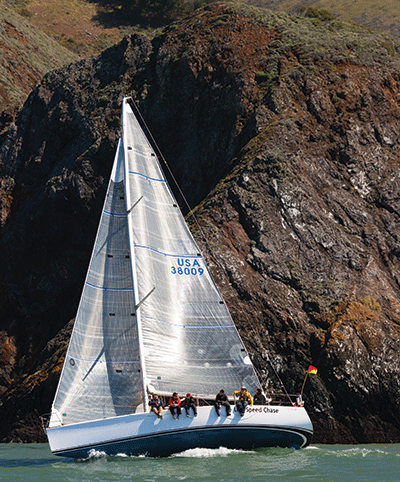One fact should be made clear up front — the crew of the Low Speed Chase had lost the race before they even began. After spending nearly a full hour backpedaling and fumbling about just trying to clear the starting buoy for the April 14 Full Crew Farallones Race, the eight sailors knew they never had a chance. They weren’t cutting too close to the islands or putting themselves in jeopardy to win a race they were keenly aware they could not win. The sailors were, on the contrary, simply reveling in a pristine day on the open ocean — moments before a seemingly infinite wave engulfed their boat and swept them into the water.
The Lay of the Land
Officially part of the city and county of San Francisco, the Farallones are a desolate and eerie series of islands 27 miles off the coast, populated only by a handful of researchers, seabirds and seals, and ringed by a teaming mass of great white sharks. Visible from the mainland on a clear day, the islands string northwestward from Southeast Farallon Island, the largest and only inhabited island, for five miles, with a total land area of 0.16 square miles. A national wildlife refuge, the islands are closed to the public. The Farallones are primitive, volcanic islands, so rather than being encircled by beaches, they are bordered by craggy, rocky and unforgiving shores.
The conditions in the open water around the Farallones are infamously challenging for sailors, with erratic winds, perilous currents and shallow reefs that can produce waves which materialize without warning and crest dozens of feet in the air almost instantaneously. Still, the daylong Full Crew Farallones Race had been run since 1907 without a single fatality — until this spring, when five sailors were swallowed by Pacific Ocean swells.
The race is sponsored by the Offshore Yacht Racing Association (OYRA), while the San Francisco Yacht Club, known as the SFYC, located in Belvedere, annually provides race management. Ocean racing is almost a different sport from sailing in the bay, and certainly more of a commitment in terms of time and stamina. The races are longer, the conditions are harsher, the physical work on the boat is more strenuous, and most of all, since offshore races are inherently unpredictable, they require sailors to have an incredible level of trust in the boat, the other crew members and the captain.
While not an exceptionally prestigious race within the yachting community, with many of the boats tending to be older, heavier and considerably less valuable than the hot, sleek sailboats entering other ocean races, the Full Crew Farallones Race nonetheless draws some of the most skilled and experienced sailors in the Bay Area and beyond. The regatta is a century-old tradition, almost an iconic event — it is to the local sailing community what the annual Dipsea Race is to area runners.
Although the SFYC manages the race, the regatta actually begins and ends at the St. Francis Yacht Club just off the Marina Green in San Francisco, as that club’s deck space more easily allows race personnel to stagger the starts and clock the boats in as they return. The racecourse winds upwind to the Golden Gate Bridge, past the headlands, and out into the ocean toward Southeast Farallon Island. Once the racers sail around the island, the midpoint of the race, they head back downwind to San Francisco. The Full Crew Farallones is a bit unusual in terms of an ocean race in that it starts in the same place it finishes (most ocean races in the Pacific involve a somewhat less convenient sail one-way down the coast), which adds to its popularity among many local sailors.
The fastest boats finish the race in just over six hours, but the race is measured in terms of corrected, or handicapped, time which adjusts for various boat speeds. This year the winner was Double Trouble out of the Corinthian Yacht Club in Belvedere, with an elapsed time of 6:11 and a corrected time of 7:28.
The competition is the only ocean race for which the SFYC offers race management services. Known as the “premier yacht club on the West Coast” as well as the “oldest yacht club west of the Mississippi in North America,” the SFYC was originally founded in 1869 in San Francisco’s China Basin. The club moved to Sausalito, then relocated to its current location on Beach Road in Belvedere in 1937. While there have been some close calls in its history, prior to April 14, no member of the SFYC had ever died in a sailing race.


